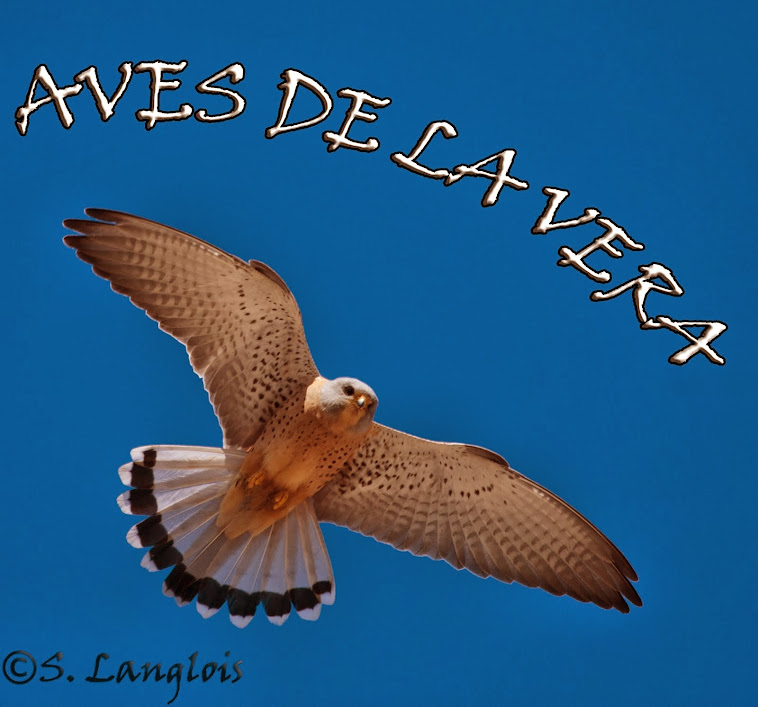¿Cuántos individuos hay en este bando de gangas?
Una de las muchas utilidades de la fotografía es poder entrenar el ojo para estimar el número de pájaros en un bando grande. En el campo casi nunca tienes tiempo para contarlos uno por uno. Tienes que estimar a bulto. Luego la foto te deja contarlos tranquilamente para probar tu precisión estimatoria. Pues en el campo a ojo dijimos 80. Contándolos ahora vemos que de hecho hay 90. Aceptable, ¿no? ¿Aprobado alto, notable bajo?
Aquí veis una foto de un grupo más pequeño más cerca para ver algo de los colores tan lindos que tienen. Y sus reclamos tan bonitos y agrestes los pudimos disfrutar durante casi toda la mañana.
¿Y cuántos hay en éste?
Un poco más fácil, ¿verdad? Pero ¿qué son? Pues, limícolas estilo chorlito, rechonchas, colicortas y piquicortas, sin línea blanca en el ala pero un muy distintiva “caña blanca” en la última primaria, algo que no todas las guías destacan. Pues sí, son chorlitos carambolos, la razón principal porque hemos vuelto este finde a la planicie entre Cáceres y Plasencia para verlos una segunda vez, siendo una de nuestras aves favoritas.
Llegamos a eso de las nueve y en el prado salpicado de rocas y cardos donde están invernando seis este año (al principio siete), ni rastro de ellos. Solamente este impresionante buitre leonado mirándonos con un poco de recelo pero no lo suficiente para lanzar su considerable peso al aire.
Por fin, después de unas horas de búsqueda de un sitio a otro, encontramos el grupito de carambolos en exactamente el mismo sitio donde había estado posado el buitre. Son aves muy entrañables, los carambolos, con sus hábitos de arrancar-frenar y casi constante caza de bichitos demasiado pequeños para ser visibles (para nosotros) entre las rocas.
Tienden a mantenerse bastante juntos pero no revueltos mientras campean entre las rocas, así que a veces se pueden fotografiar dos a la vez:
o incluso 4:
Aunque todos siguen en plumaje invernal se ve que el próximo individuo ya tiene un atisbo de naranja en los flancos:
Todos tienen la línea blanca pectoral y la lista superciliar fuerte que nunca pierden:
Y en estas dos últimas fotos se ve el dibujo tan bonito de su píleo:
Está por ver ahora cuánto tiempo más se quedan entre nosotros antes de volver al norte y si se dejan entrever otros indicios de sus galas de verano mientras tanto.
English translation of thetext:
A SECOND VISIT TO THE LOCAL DOTTERELS
How many birds are there in this flock of Pintailed Sandgrouse? One of the many good things about photography is that it can help you “get your eye in” in terms of estimating flock numbers in the field. You’ve seldom got time to count them one by one on the spot, so you have to come up with a quick estimation. A photo then allows you count them afterwards to test your estimation accuracy. In the field we estimated 80 and a count of the photo shows there are in fact 90. Not bad, but room for improvement as my teachers might say. The next photo shows a smaller and closer-up flock of Pintailed Sandgrouse to see something of their lovely plumage. And we were able to enjoy their eerily wild cries the whole morning.
In the next photo it’s easy to see there are four birds, but what species are they? Obviously they are plumpish, short-tailed and -beaked plover-type waders with no wing bar but a very distinctive white shaft on the outer primary, something not all the identification guides mention but which shows up well here on all four of them. Well, yes, they’re Dotterels, the main reason we returned this weekend to the plain between Cáceresand Plasenciato see them for a second time, since they’re one of our favourite birds.
We got there about nine and on the rock- and thistle-dotted prairie where six Dotterels are wintering this year (7 at first but one disappeared), there was no trace of them. Only this impressive Griffon Vulture, looking at us a bit charily but not spooked enough to launch its considerable bulk into the air.
At last, after traipsing about from one spot to another, we found the Dotterel flock in almost exactly the same spot where the Vulture had been sitting. They’re beautiful birds to watch, with their stop-go hunting runs among the rocks. The flock tends to stay sort of loosely together while feeding so you can sometimes photograph two or even four together. Although they’re all still in winter plumage you can see a hint of orange flush on the flanks of one of them. All of them have the white pectoral band and the strong eye stripe, which they never lose. The last two photos show their lovely streaked crowns. It now remains to be seen how much longer they stay with us before heading north and whether they show any other glimpses of their developing summer plumage over the coming weeks.

















